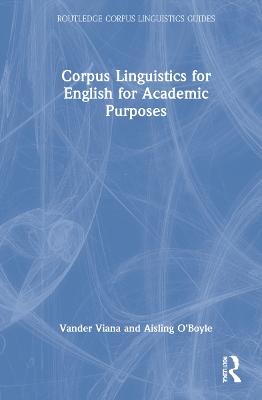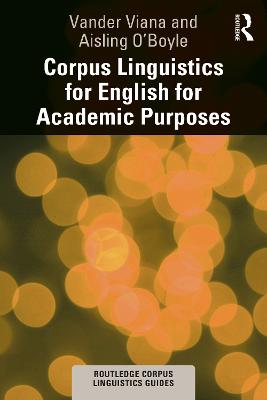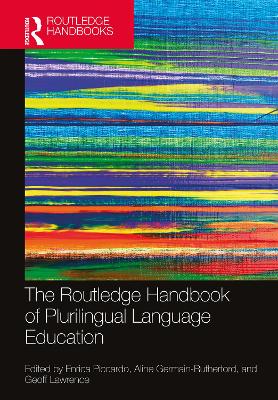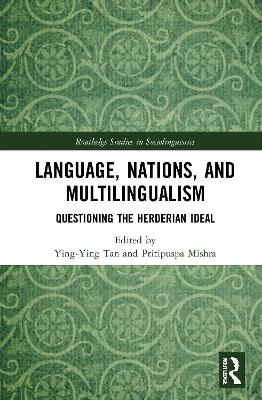Corpus Linguistics for English for Academic Purposes
 -10%
portes grátis
-10%
portes grátis
Corpus Linguistics for English for Academic Purposes
Viana, Vander; O'Boyle, Aisling
Taylor & Francis Ltd
12/2021
260
Dura
Inglês
9781138741317
15 a 20 dias
671
Descrição não disponível.
Chapter 1: Introduction
1.1) What is EAP?
1.2) Why have we written this book?
1.3) How is this book structured?
Chapter 2: EAP in its contexts
2.1) How do English and changing academic landscapes shape each other?
2.2) What is academic discourse?
2.3) How do academic disciplines relate to English language use?
Chapter 3: CL for the EAP community
3.1) What is a corpus?
3.2) What is the difference between general and specialized corpora?
3.3) How else can corpora be categorized?
3.4) What specialized academic English corpora are freely available?
3.5) What are the principles of corpus analysis?
Chapter 4: EAP and CL (non-)interfaces
4.1) What can a corpus perspective bring to EAP?
4.2) What EAP questions cannot be answered by corpus analyses?
4.3) What EAP questions can be answered by corpus analyses?
Chapter 5: Specialized corpus compilation for EAP
5.1) Why would you compile a corpus?
5.2) How specialized can your corpus be?
5.3) What criteria can inform your corpus compilation plan?
5.4) What should you consider in relation to sampling, balance and size?
5.5) What ethical matters are involved in corpus compilation?
5.6) What relevant decisions should you make before collecting data?
5.7) What practical aspects can impact your data collection plan?
5.8) What tasks do you need to undertake when building your corpus?
5.8.1) What is particular about corpora of spoken academic discourse?
5.8.2) What is particular about corpora of written academic discourse?
5.8.3) What is particular about corpora of CMAD?
5.9) What else should you consider before project completion?
Chapter 6: Corpus analysis for EAP
6.1) What do you need to do before the analysis?
6.2) What information do wordlists provide?
6.3) What information do lists of word sequences provide?
6.4) What information do concordance lines provide?
6.5) What information do keywords provide?
6.6) What information do collocations provide?
Chapter 7: Corpus research on spoken academic discourse
7.1) What is spoken academic discourse (or how is it different from written academic discourse)?
7.2) Whose turn is it anyway?
7.3) I'm listening - can't you tell?
7.4) Can I ask?
7.5) Does formulaic language contribute to spoken academic fluency? 'Oh, I don't know'
7.6) Can you present your thesis in three minutes?
Chapter 8: Corpus research on written academic discourse
8.1) What do outward and inward examinations of written academic discourse reveal?
8.2) To cite or not to cite? The actual question is how...
8.3) Is it the case or does it seem so?
8.4) What lexical maps can CL offer EAP?
8.5) In which discipline would these bundles be found?
Chapter 9: Corpus research on computer-mediated academic discourse
9.1) CMD vs. CMAD: what difference does 'A' letter make?
9.2) Blogging for academic purposes -What is the point?
9.3) How do I e-m@il u?
9.4) How do I participate in discussions forums? ?? ?
Chapter 10: Conclusion
1.1) What is EAP?
1.2) Why have we written this book?
1.3) How is this book structured?
Chapter 2: EAP in its contexts
2.1) How do English and changing academic landscapes shape each other?
2.2) What is academic discourse?
2.3) How do academic disciplines relate to English language use?
Chapter 3: CL for the EAP community
3.1) What is a corpus?
3.2) What is the difference between general and specialized corpora?
3.3) How else can corpora be categorized?
3.4) What specialized academic English corpora are freely available?
3.5) What are the principles of corpus analysis?
Chapter 4: EAP and CL (non-)interfaces
4.1) What can a corpus perspective bring to EAP?
4.2) What EAP questions cannot be answered by corpus analyses?
4.3) What EAP questions can be answered by corpus analyses?
Chapter 5: Specialized corpus compilation for EAP
5.1) Why would you compile a corpus?
5.2) How specialized can your corpus be?
5.3) What criteria can inform your corpus compilation plan?
5.4) What should you consider in relation to sampling, balance and size?
5.5) What ethical matters are involved in corpus compilation?
5.6) What relevant decisions should you make before collecting data?
5.7) What practical aspects can impact your data collection plan?
5.8) What tasks do you need to undertake when building your corpus?
5.8.1) What is particular about corpora of spoken academic discourse?
5.8.2) What is particular about corpora of written academic discourse?
5.8.3) What is particular about corpora of CMAD?
5.9) What else should you consider before project completion?
Chapter 6: Corpus analysis for EAP
6.1) What do you need to do before the analysis?
6.2) What information do wordlists provide?
6.3) What information do lists of word sequences provide?
6.4) What information do concordance lines provide?
6.5) What information do keywords provide?
6.6) What information do collocations provide?
Chapter 7: Corpus research on spoken academic discourse
7.1) What is spoken academic discourse (or how is it different from written academic discourse)?
7.2) Whose turn is it anyway?
7.3) I'm listening - can't you tell?
7.4) Can I ask?
7.5) Does formulaic language contribute to spoken academic fluency? 'Oh, I don't know'
7.6) Can you present your thesis in three minutes?
Chapter 8: Corpus research on written academic discourse
8.1) What do outward and inward examinations of written academic discourse reveal?
8.2) To cite or not to cite? The actual question is how...
8.3) Is it the case or does it seem so?
8.4) What lexical maps can CL offer EAP?
8.5) In which discipline would these bundles be found?
Chapter 9: Corpus research on computer-mediated academic discourse
9.1) CMD vs. CMAD: what difference does 'A' letter make?
9.2) Blogging for academic purposes -What is the point?
9.3) How do I e-m@il u?
9.4) How do I participate in discussions forums? ?? ?
Chapter 10: Conclusion
Este título pertence ao(s) assunto(s) indicados(s). Para ver outros títulos clique no assunto desejado.
EAP;Corpus-based approaches to EAP;Esp;EAP and teaching;English As A Lingua Franca;ESP research;Research Articles;ESP teaching;Lexical Bundles;Corpus materials and EAP;Elf;Corpora for EAP;Modal Verb;Corpus Analyses;Lingua Franca;EMI;Academic Prose;Coca;Knowledge 8E;Corpus Compilation;EAP Student;British Academic Written English Corpus;Concordance Lines;EAP Practitioner;Transcript Id;Genre Families;BNC;Formulaic Sequences;Discussion Forums;Keyword Analysis;EAP Research
Chapter 1: Introduction
1.1) What is EAP?
1.2) Why have we written this book?
1.3) How is this book structured?
Chapter 2: EAP in its contexts
2.1) How do English and changing academic landscapes shape each other?
2.2) What is academic discourse?
2.3) How do academic disciplines relate to English language use?
Chapter 3: CL for the EAP community
3.1) What is a corpus?
3.2) What is the difference between general and specialized corpora?
3.3) How else can corpora be categorized?
3.4) What specialized academic English corpora are freely available?
3.5) What are the principles of corpus analysis?
Chapter 4: EAP and CL (non-)interfaces
4.1) What can a corpus perspective bring to EAP?
4.2) What EAP questions cannot be answered by corpus analyses?
4.3) What EAP questions can be answered by corpus analyses?
Chapter 5: Specialized corpus compilation for EAP
5.1) Why would you compile a corpus?
5.2) How specialized can your corpus be?
5.3) What criteria can inform your corpus compilation plan?
5.4) What should you consider in relation to sampling, balance and size?
5.5) What ethical matters are involved in corpus compilation?
5.6) What relevant decisions should you make before collecting data?
5.7) What practical aspects can impact your data collection plan?
5.8) What tasks do you need to undertake when building your corpus?
5.8.1) What is particular about corpora of spoken academic discourse?
5.8.2) What is particular about corpora of written academic discourse?
5.8.3) What is particular about corpora of CMAD?
5.9) What else should you consider before project completion?
Chapter 6: Corpus analysis for EAP
6.1) What do you need to do before the analysis?
6.2) What information do wordlists provide?
6.3) What information do lists of word sequences provide?
6.4) What information do concordance lines provide?
6.5) What information do keywords provide?
6.6) What information do collocations provide?
Chapter 7: Corpus research on spoken academic discourse
7.1) What is spoken academic discourse (or how is it different from written academic discourse)?
7.2) Whose turn is it anyway?
7.3) I'm listening - can't you tell?
7.4) Can I ask?
7.5) Does formulaic language contribute to spoken academic fluency? 'Oh, I don't know'
7.6) Can you present your thesis in three minutes?
Chapter 8: Corpus research on written academic discourse
8.1) What do outward and inward examinations of written academic discourse reveal?
8.2) To cite or not to cite? The actual question is how...
8.3) Is it the case or does it seem so?
8.4) What lexical maps can CL offer EAP?
8.5) In which discipline would these bundles be found?
Chapter 9: Corpus research on computer-mediated academic discourse
9.1) CMD vs. CMAD: what difference does 'A' letter make?
9.2) Blogging for academic purposes -What is the point?
9.3) How do I e-m@il u?
9.4) How do I participate in discussions forums? ?? ?
Chapter 10: Conclusion
1.1) What is EAP?
1.2) Why have we written this book?
1.3) How is this book structured?
Chapter 2: EAP in its contexts
2.1) How do English and changing academic landscapes shape each other?
2.2) What is academic discourse?
2.3) How do academic disciplines relate to English language use?
Chapter 3: CL for the EAP community
3.1) What is a corpus?
3.2) What is the difference between general and specialized corpora?
3.3) How else can corpora be categorized?
3.4) What specialized academic English corpora are freely available?
3.5) What are the principles of corpus analysis?
Chapter 4: EAP and CL (non-)interfaces
4.1) What can a corpus perspective bring to EAP?
4.2) What EAP questions cannot be answered by corpus analyses?
4.3) What EAP questions can be answered by corpus analyses?
Chapter 5: Specialized corpus compilation for EAP
5.1) Why would you compile a corpus?
5.2) How specialized can your corpus be?
5.3) What criteria can inform your corpus compilation plan?
5.4) What should you consider in relation to sampling, balance and size?
5.5) What ethical matters are involved in corpus compilation?
5.6) What relevant decisions should you make before collecting data?
5.7) What practical aspects can impact your data collection plan?
5.8) What tasks do you need to undertake when building your corpus?
5.8.1) What is particular about corpora of spoken academic discourse?
5.8.2) What is particular about corpora of written academic discourse?
5.8.3) What is particular about corpora of CMAD?
5.9) What else should you consider before project completion?
Chapter 6: Corpus analysis for EAP
6.1) What do you need to do before the analysis?
6.2) What information do wordlists provide?
6.3) What information do lists of word sequences provide?
6.4) What information do concordance lines provide?
6.5) What information do keywords provide?
6.6) What information do collocations provide?
Chapter 7: Corpus research on spoken academic discourse
7.1) What is spoken academic discourse (or how is it different from written academic discourse)?
7.2) Whose turn is it anyway?
7.3) I'm listening - can't you tell?
7.4) Can I ask?
7.5) Does formulaic language contribute to spoken academic fluency? 'Oh, I don't know'
7.6) Can you present your thesis in three minutes?
Chapter 8: Corpus research on written academic discourse
8.1) What do outward and inward examinations of written academic discourse reveal?
8.2) To cite or not to cite? The actual question is how...
8.3) Is it the case or does it seem so?
8.4) What lexical maps can CL offer EAP?
8.5) In which discipline would these bundles be found?
Chapter 9: Corpus research on computer-mediated academic discourse
9.1) CMD vs. CMAD: what difference does 'A' letter make?
9.2) Blogging for academic purposes -What is the point?
9.3) How do I e-m@il u?
9.4) How do I participate in discussions forums? ?? ?
Chapter 10: Conclusion
Este título pertence ao(s) assunto(s) indicados(s). Para ver outros títulos clique no assunto desejado.
EAP;Corpus-based approaches to EAP;Esp;EAP and teaching;English As A Lingua Franca;ESP research;Research Articles;ESP teaching;Lexical Bundles;Corpus materials and EAP;Elf;Corpora for EAP;Modal Verb;Corpus Analyses;Lingua Franca;EMI;Academic Prose;Coca;Knowledge 8E;Corpus Compilation;EAP Student;British Academic Written English Corpus;Concordance Lines;EAP Practitioner;Transcript Id;Genre Families;BNC;Formulaic Sequences;Discussion Forums;Keyword Analysis;EAP Research







